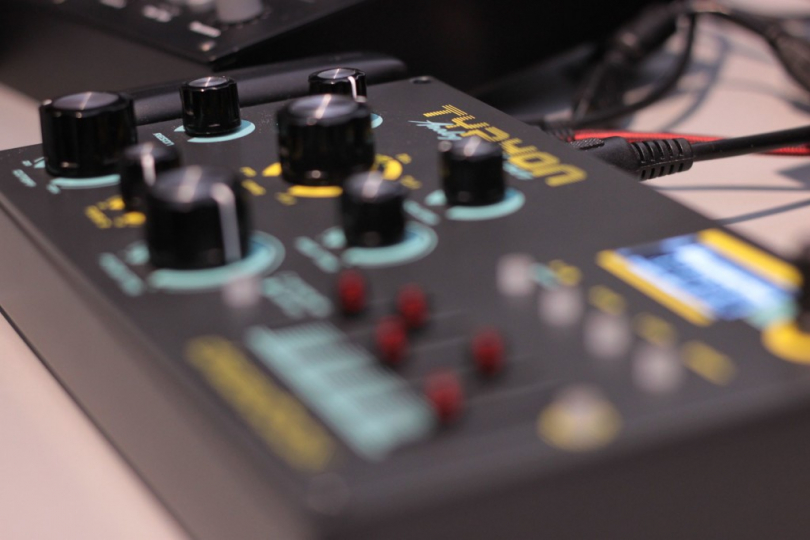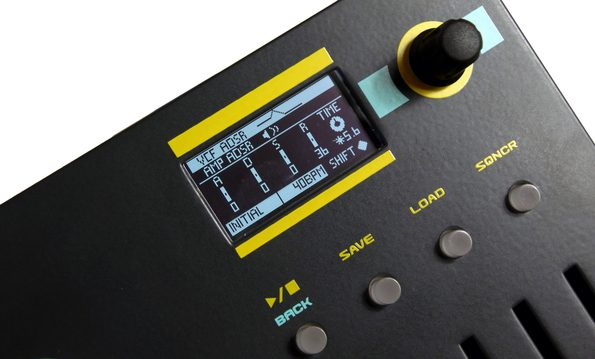
A Greek God: Dreadbox Typhon
Although defeated by Zeus’ thunderbolts, Typhon was one of the deadliest creatures to challenge the established hierarchy of gods in Greek mythology. Typhon was a giant, a monstrous entity of crafty ways, capable of taking on traditional order—and kicking ass. Dreadbox’s Typhon synthesizer is an accurate representation of the myth. If the name fits, slap it on a product.
For almost a decade, Dreadbox has been hand-making boutique analogue synths, modules, and effects processors in a small workshop in Athens, Greece. They have always been a bit hard to acquire and seemingly pricey. However, you get what you pay for: musical instruments made by musicians. This is quite rare in the synth world, unlike all the Korgs, Behringers, and Rolands flooding the market with affordable factory-made sound machines. I have nothing against those products, but there is nothing like homemade Greek melomakarona compared to a box of it pulled from the freezer aisle.
The many-headed monster
Typhon is a two-oscillator monophonic analogue synthesizer. That doesn’t sound too exciting, does it? Well, read on and maybe your mind will change—mine did. Once you throw in digital control (we can’t have our oscillators going out of tune, unless we want them to), sequencing, an extremely extensive mod matrix and Sinevibes digital effects, the Typhon starts adding up to be one versatile and usable synth, great for any studio, desktop, beach chair, or live performance.
My big fat Greek… wait, this thing is tiny (23cm x 13cm)! It’s a tad bigger than Korg Volcas, but is built like a mini tank. The enclosure is heavy-duty metal, the knobs and faders are quality with just the right amount of resistance (nothing worse than wobbly knobs) and everything feels like time and effort was put into getting things right. An OLED screen clearly tells you what the hell you are twiddling with and, even though the screen is only several centimetres across, everything is laid out in a way that is instantly recognizable and user friendly. Even though the chassis has only 8 knobs, 5 faders, and a few buttons, there is almost no menu-diving. The screen is there to help you, not hinder your artistry. As far as connections are concerned, it’s got 5 pin-din midi in and outs, full-size stereo audio outs and has received a recent update which gives it USB midi and audio. Plug in and get going.

Honey dripping analogue
Oh, the sound. Dreadbox is known for smooth-sounding oscillators. Typhon’s dual VCOs do not stray from that legacy. There is always a warmth to analogue. Don’t get me wrong—with a bit of tweaking and fiddling with equalizers, compressors, distortion, etc. you can get somewhere close to the analogue sound on a digital synth, but Typhon smothers you in silky sappy honey right out of the box. It offers saw, triangle, and square waveforms, with a lot in between. You can go from eardrum massaging pulse-width modulation to a screaming super-saw with a twist of the VCO mixer knob. There is even a basic frequency modulation setting on the dial for those who like to modulate oscillators with oscillators. No algorithms here though—this ain't a DX7. Typhon’s 4-pole 24db VCF and dual VCAs round out the analogue signal path before it tosses you into turbulent digital seas of effects processing.
Is digital a dirty word?
I used to be a purist. I have looked down my nose at digital synths, samplers, and romplers. I have tut-tutted at musicians using only soft-synths… well, I still do on that point—hardware rocks! Anyway, those days are over. I am calming down in my old age. When sitting down to make music, do we really want to prepare a synth by patching in a hundred cables? Connecting LFOs and envelopes and everything in between with a spaghetti-like Medusa’s head of wires, connecting patch points to patch points to patch points? You get the picture. And effects... everything sounds better with kick-ass reverb, chorus, and distortion thrown in. Typhon’s digital side is fabulous and makes creating music, well, just easier. There can be up to three effects slots in the chain. These run parallel to the analogue signal, so purists out there can feel a bit better. The effects algorithms were created by Sinevibes. You can imagine the quality. The freaking reverb is massive! The modulation matrix is amazing—generally, everything can modulate everything, it seems. There are even possibilities to randomize everything using sample and hold probabilities for each step on the 32 step sequencer—the possibilities seem endless. I must stop gushing, but a lot of what Typhon has to offer can be found only on synths that cost a lot more, a whole lot more. I find myself sitting down with Typhon and creating. No fuss, just getting lost in sound. Isn’t that what it’s all about?
Damn you Zeus… keep those thunderbolts to yourself!
Hardware synths are making a comeback. Roland seems to come out with a boutique version of their classics every year and Behringer are remaking everything under the Sun. Great sounding stuff, all of it. However, I like going for the underdog, a small synth family. Every time I twist a knob or push a fader on my Typhon, I know that a musician’s heart went into creating it. I know that the person who soldered the components actually has one and enjoys playing it, as well. I know that they are in the zone. It sounds spectacular, too! It’s hard to find these kinds of products nowadays and, when you do, you gotta stick with them. I will stick with Dreadbox—I just wish I could persuade my wife to let me get a couple more.
If you have found an error or typo in the article, please let us know by e-mail info@insounder.org.

